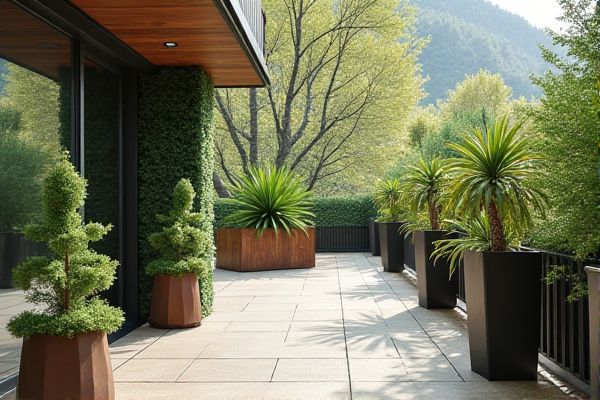
Planters and plant stands both enhance terrace decor by showcasing greenery, but planters directly hold soil and plants, offering functionality and variety in size and design, while plant stands elevate pots off the ground, adding vertical interest and space-saving benefits. Explore the rest of the article to discover which option best suits your terrace and style.
Table of Comparison
| Feature | Planters | Plant Stands |
|---|---|---|
| Function | Directly hold soil and plants | Elevate pots or planters for display |
| Material | Ceramic, plastic, terracotta, metal | Metal, wood, bamboo, wrought iron |
| Design | Varied shapes and sizes for plant growth | Stylish, decorative frames to enhance visual appeal |
| Water Drainage | Often includes drainage holes | Depends on planter used, no drainage function |
| Mobility | Usually stationary and heavier | Lightweight and easy to move |
| Space Optimization | Requires floor or surface space | Vertical storage, saves floor space |
| Decorative Use in Terrace | Direct planting enhances greenery | Adds height and dimension to terrace decor |
Introduction to Terrace Decor: Planters vs Plant Stands
Terrace decor enhances outdoor living spaces by combining functionality and aesthetics, with planters and plant stands serving distinct roles. Planters provide a direct home for your plants, offering a variety of materials and sizes to support plant health and style. Plant stands elevate your greenery, creating visual interest and maximizing space, making your terrace decor more dynamic and organized.
Defining Planters and Plant Stands
Planters are containers specifically designed to hold soil and plants, offering a self-contained environment for growing flowers, herbs, or small shrubs. Plant stands serve as elevated platforms or decorative structures that support planters, enhancing visibility and aesthetic appeal while enabling better drainage and air circulation. Choosing between planters and plant stands depends on the desired functionality, space optimization, and style preferences for terrace decor.
Space Utilization: Maximizing Your Terrace
Planters allow you to grow plants directly in the soil or containers, providing a natural and flexible way to utilize space efficiently on your terrace. Plant stands elevate pots vertically, helping you maximize limited areas by creating multi-level displays that enhance visual interest and airflow. Choosing the right combination of planters and plant stands can significantly optimize your terrace layout, making the most of every inch for a lush and organized outdoor space.
Aesthetic Appeal: Styles and Designs Compared
Planters offer a variety of shapes, colors, and materials that can seamlessly blend with your terrace decor, providing a natural and organic aesthetic. Plant stands elevate your greenery, often featuring intricate designs and allowing for multi-level displays that add depth and visual interest to your outdoor space. Choosing between planters and plant stands depends on whether you prioritize grounded simplicity or dynamic layered arrangements in your terrace design.
Material Choices: Durability and Care
Planters made from ceramic, terracotta, or resin offer durability with minimal maintenance, ideal for outdoor terraces exposed to varying weather conditions. Plant stands typically feature metal or wood materials, providing sturdy support but requiring regular care like rust prevention for metal or sealing for wood to extend their lifespan. Selecting materials based on durability and ease of care ensures your terrace decor remains attractive and functional over time.
Flexibility and Versatility in Arrangement
Planters offer direct soil planting, making them ideal for growing a variety of plants in fixed spots, while plant stands provide elevated and mobile display options for easy rearrangement on terraces. The versatility of plant stands allows for multi-level arrangements, optimizing limited terrace space and enhancing aesthetic appeal. Flexibility in placement with plant stands supports changing sunlight patterns and design preferences, unlike traditional planters that remain static once positioned.
Plant Health: Drainage and Sunlight Considerations
Planters designed with built-in drainage holes prevent waterlogging, promoting root health and preventing fungal growth, while many plant stands lack proper drainage, potentially harming sensitive plants. Elevating plants on stands enhances sunlight exposure by reducing shading and improving air circulation, crucial for photosynthesis and overall vigor, compared to ground-level planters. Selecting terrace decor with appropriate drainage and height optimizes both moisture control and light access, fostering robust plant development.
Budget Considerations: Cost Analysis
Planters generally offer a more budget-friendly option for terrace decor, with prices varying based on materials like plastic, ceramic, or terracotta, often costing between $10 and $50. Plant stands, especially those made from metal or wood with intricate designs, tend to be pricier, ranging from $30 to $100 or more, but can enhance the height and visual interest of your plants. Your choice should balance initial investment with aesthetic preferences, considering durability and how each piece complements the overall terrace design.
Maintenance and Upkeep Requirements
Planters require regular watering, soil replacement, and monitoring for root health to ensure your plants thrive, often demanding more frequent maintenance than plant stands. Plant stands primarily support pots and focus on stability and protection from moisture damage, requiring occasional cleaning and structural checks. Choosing between them depends on your willingness to manage ongoing plant care versus the simpler upkeep of decorative support.
Choosing the Right Option for Your Terrace Decor
Selecting between planters and plant stands for your terrace decor depends on functionality and aesthetic preferences; planters offer a versatile and self-contained solution for planting, while plant stands provide elevation and visual interest by showcasing pots at varying heights. Consider the size and style of your terrace, as well as the types of plants you want to display, to ensure optimal use of space and sunlight exposure. Your choice impacts not only the visual appeal but also the maintenance ease and overall ambiance of your outdoor living area.
 homyna.com
homyna.com